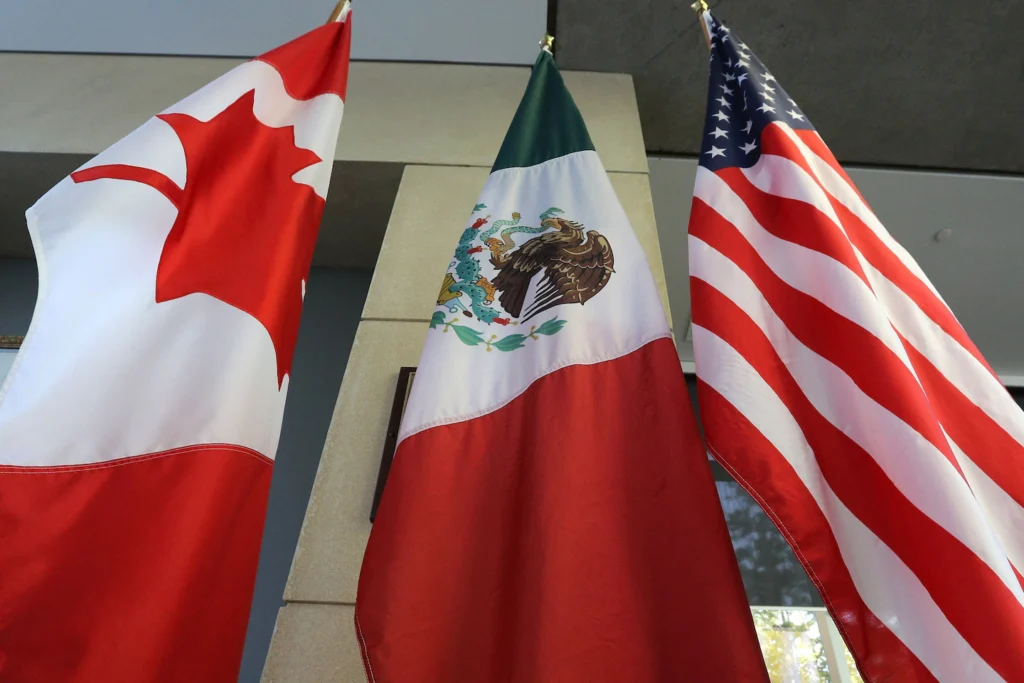U.S. President Donald Trump has once again ignited trade tensions by announcing a 25% tariff on imports from Mexico and Canada, set to take effect on March 4. The move, which comes as part of his campaign rhetoric for the 2024 presidential race, has sent shockwaves through North American trade partners and global markets. While Trump has long been known for his protectionist policies, this drastic measure raises concerns about economic consequences, diplomatic relations, and the future of the United States-Mexico-Canada Agreement (USMCA).
A Return to Protectionist Policies
Trump’s announcement is reminiscent of his 2018 trade war, during which he imposed tariffs on steel and aluminum imports, triggering retaliatory measures from both Canada and Mexico. His latest move is being framed as a way to protect American manufacturing jobs and counter what he describes as “unfair trade practices.” According to Trump, the tariff is necessary to curb what he claims is a surge in foreign-made goods undermining domestic production, particularly in the auto and steel industries.
“For too long, Mexico and Canada have been taking advantage of the American economy,” Trump stated at a rally. “We’re going to bring back our jobs, rebuild our industries, and make America great again.”
Economic Fallout and Industry Reactions
Economists and industry leaders have reacted with alarm, warning that a 25% tariff could have severe repercussions for supply chains, inflation, and consumer prices. The North American market is deeply integrated, with industries like automobiles, agriculture, and energy relying heavily on cross-border trade.
In the auto industry, for example, vehicles assembled in the U.S. often contain parts manufactured in Canada and Mexico. A tariff on imports would raise costs for automakers, potentially leading to higher car prices for American consumers. The American Automotive Policy Council, which represents major automakers like Ford, General Motors, and Stellantis, has expressed concern that such tariffs would disrupt production and hurt competitiveness.
Similarly, agricultural producers fear retaliatory tariffs from Mexico and Canada, both of whom are significant buyers of U.S. farm goods. Mexico is the top export market for American corn, dairy, and pork, while Canada imports vast amounts of U.S. wheat and beef. Farmers, who were hit hard by previous trade disputes, worry that a fresh tariff war would jeopardize their access to these critical markets.
Diplomatic Backlash and USMCA at Risk
Trump’s announcement has drawn strong reactions from leaders in Canada and Mexico, both of whom have emphasized the importance of free trade and economic cooperation. Canadian Prime Minister Justin Trudeau condemned the move, calling it “an unjustified attack on North American economic stability.” Mexican President Andrés Manuel López Obrador also criticized the decision, stating that his government “will not stand idly by” if Mexico’s economy is harmed.
Both nations have hinted at possible retaliatory measures, which could escalate into a full-blown trade war. Moreover, this tariff threatens the stability of the USMCA, the trade agreement that replaced NAFTA in 2020. The USMCA was designed to ensure fair and reciprocal trade among the three countries, and many analysts believe Trump’s decision could lead to a renegotiation or outright collapse of the agreement.
Political Calculations and Campaign Strategy
Trump’s tariff proposal is widely seen as part of his campaign strategy to appeal to working-class voters in key swing states like Michigan, Pennsylvania, and Ohio—regions with a strong manufacturing base that have historically supported protectionist trade policies. By taking a hard stance on trade, Trump aims to energize his voter base and differentiate himself from President Joe Biden, whom he accuses of being weak on trade enforcement.
However, the policy is also a gamble. While some blue-collar workers may support it, many businesses and consumers are likely to feel the negative effects of higher costs. Furthermore, it risks alienating moderate Republicans and independent voters who favor free trade.
Market and Global Implications
Financial markets have already reacted to Trump’s announcement, with stock prices of major automakers, retailers, and consumer goods companies experiencing fluctuations. Investors worry that trade uncertainty could slow economic growth, especially at a time when the Federal Reserve is managing inflation concerns.
On a global scale, Trump’s tariff proposal could also strain relations with other trading partners. If Canada and Mexico retaliate with their own tariffs, it could trigger disruptions beyond North America, potentially impacting trade with European and Asian markets as well.
Conclusion: A Risky Move with Uncertain Outcomes
Trump’s proposed 25% tariff on Mexico and Canada is a bold but risky maneuver that could have far-reaching economic and political consequences. While it plays into his long-standing protectionist narrative, the move is fraught with risks, including potential retaliation, disruptions in key industries, and inflationary pressures on consumers.
As the March 4 implementation date approaches, businesses, workers, and policymakers alike will be closely watching the developments. Whether this policy strengthens Trump’s electoral appeal or backfires by harming the U.S. economy remains to be seen, but one thing is clear: North America is once again on the brink of a trade conflict that could reshape economic dynamics for years to come.

